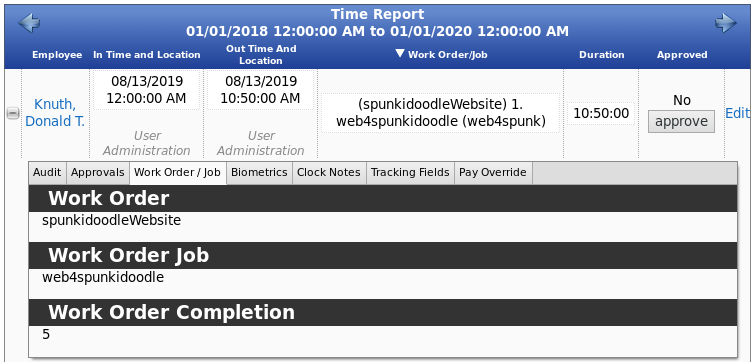
316-264-1600 Information Information Sales Sales Support Support |
|
Applies to versions: 3.0, 3.1Time Edit/ReportThe Time Edit/Report interface is designed to be a quick, simple, easy to use yet powerful and flexible tool for viewing employee worked time, benefit time, and holiday time. This support article will walk you through the basics of the interface itself for the most common tasks, and also explore some of the features and options that make the Time Edit/Report a powerful tool for running your business. NOTE: The IPSPRM Module provides access to the Time Edit/Report Interface which is controlled by the Clock Events permission. Any employee that can view worked time will be able to access the interface itself. The content of the reports are restricted by the Employee's permission to view Clock Events, Benefits, and Holiday Events for other employees. These reports will be restricted by these permissions as well.
Using the left pane Main Menu under Administration, click on: Reports » Time Edit/Report
Generate a Report Using Presets
This will populate the Date Range, Employees, and Columns to display, as well as any advanced options you might have included.
Generate a Report Manually
Summarized Time ReportThe columns that are visible in this report can be set up using the presets provided in the Control Panel. In the default preset, the Summarized Time Report shows a basic summary of information. Clicking on an Employee's name will generate a Detailed Time Report for that person. In this example, the report is displaying a summarized view of the worked time for All Visible Employees in Programmers. There are three people with time in this report. One person, Donald Knuth, used 24 hours of benefit time during this time range, while all three received 8 hours of holiday pay.
Detailed Time ReportThe Detailed Time Report displays all the information about the clocked time, including the Job, Work Order, Clock Location, and Duration of the event. More details are available in different columns (For example, Timesheet Approval for Event is a new column in TimeIPS 3.0+), which can be configured using the Presets for the Detailed Time Report. By clicking on Donald Knuth's name in the Summarized Time Report, we are able to view his detailed information.
EditThis report includes many of the edit-in-place columns including In Time and Location, Out Time and Location, Work Order/Job, and Duration. The Approved column also allows administrators to either approve or unapproved each time event, or approve all by clicking the Approve All Shown Events button. Clicking Edit will take you to the Time Edit interface where the clock event can be modified or even deleted.
See the Editing Time In/Out or Adding Notes to Time Events article for additional instructions.
Audit DetailsTo view the Auditing information about an event, you can expand the row by clicking the + (plus) sign to the left of the row. In this audit, we can see that Donald was clocked in and out by Matthew Keeler using "Batch Time Entry". Other clocking audit details are listed under the In and Out sections, and non-clocking audit details are listed under the Event section.
ApprovalsTo view the Approvals for an event, expand the row by clicking the + (plus) sign to the left of the row, then click on the Approvals tab. Here we can see that Donald's time was approved by Kishna Loupi on August 28th, but the event changes on December 18th caused the event to become unapproved once again and will need to be manually approved. Since "Timesheet Approval for Events" was chosen from the Detailed Presets page, this event can easily be approved right here by clicking the approve button.
Work Order/Job DetailsTo view the Work Order and Job details for an event, expand the row by clicking the + (plus) sign to the left of the row, then click on the Work Order/Job tab. Here we can see that Donald's website job is 5% complete.
BiometricsTo view the Biometric details for an event, expand the row by clicking the + (plus) sign to the left of the row, then click on the Biometrics tab. Here we can see that Donald did not receive an optic score, concluding he did not use biometrics to clock.
Clock NotesTo view the Clock Note details for an event, expand the row by clicking the + (plus) sign to the left of the row, then click on the Clock Notes tab.
Tracking FieldsTo view the Tracking Field details for an event, expand the row by clicking the + (plus) sign to the left of the row, then click on the Tracking Fields tab. Tracking Fields are displayed in bold. If an option for that tracking field was chosen during clock in or clock out, it will be displayed next to the tracking field. For example, Donald selected "Yes" to being off-site, and "customer" to whom he is training. When he clocked out, he chose "Yes" to training complete. Tracking Fields are setup under the Clocking section of TimeIPS. See the Tracking Fields article for instructions.
Pay Override DetailsTo view the Pay Override details for an event, expand the row by clicking the + (plus) sign to the left of the row, then click on the Pay Override tab. For this clock event, Donald is receiving a $1.50 per hour differential on top of his standard pay.
Advanced OperationBy Showing Advanced Options on the Control Panel, you can enable additional options for advanced operation.
And just like the Detailed Time Report, you can expand the individual rows to see more detailed information about the range you have selected. Click on the + (plus) sign to the left of the clock entry, then click the + (plus) sign to the left of the employees name for more detail.
Create New Preset
Export to CSVLike most reports in TimeIPS, the Time Edit/Report can generate a Comma-Separated-Value export file.
|
















